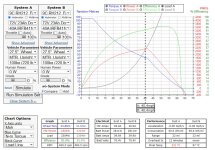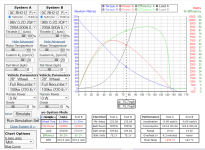Bullfrog said:
Another run using the RH212 with the Kv set to 20, 96v battery, 26" wheel, and Full Recumbent drag. Assuming your battery and controller that can supply the amperage, I'd say you are going to have a very difficult time getting over ~80 mph.
On the contrary:
https://ebikes.ca/tools/simulator.h...rame=cust_0.06_0.007&mass=120&hp=200&axis=mph
93 mph, using a 27S5P pack of Panasonic NCR21700s(3.7Vnom, 5AH, 0.00014Ohm), with a 75A battery current limit, 250A phase current limit, 200W of pedaling, assuming 0.06 m^2 CdA, 0.007 Crr, with a 260 lb laden weight, with a Leafbike 1500W 3T wind(17.48 kV) in a 20" drive wheel using a Mitas MC2 16x2.25" tire. I'm designing my new shell off of my Milan SL velomobile, which has a CdA value of about 0.03 m^2, and I'm assuming my concessions to practicality(more ground clearance, easier to access mechanical bits, wider front track for improved cornering/lateral Gs, ect) and larger frontal area will double its drag. This is only 7 kW peak, 3.3kW of which are needed to maintain top speed according to my simulation linked above. I'm seriously planning on going to 10 kW peak with a larger pack or maybe running the cells @ 20A peak if I implement thermal management, and perhaps even going to a 108V nominal pack if the appropriate controller for that comes out next year. Heat buildup may not be a big issue even @ 20A per cell because I'll be at top speed in about 20 seconds from a stop.
Here's a simulation @ 108Vnom with a 30S5P pack of Panasonic NCR21700s with a 15A per cell limit:
https://ebikes.ca/tools/simulator.h..._0.06_0.007&mass=120&hp=200&axis=mph&kv=17.48
101 mph. 4.3kW required.
Things get retarded if I go to the 130V the PowerVelocity controllers are capable of:
https://ebikes.ca/tools/simulator.h..._0.06_0.007&mass=120&hp=200&axis=mph&kv=17.48
118 mph. 6.8kW required.
The best part is that with the motor shut off and nothing to kill its cogging losses(dead battery) this thing will be able to be pedaled to 25+ mph cruising speed on flat ground with 150W, 30 mph with 225W, and maybe reach 45+ mph in a 500W sprint. So range anxiety won't exist. Of course, being able to do 60+ miles @ 90+ mph would be nice too, but not sure the motor could handle that even with the cooling mods. 3-4kW wouldn't be too hard on it though for a few minutes at a time, so a little bit of high-speed jackassery on the highway would be quite viable. She's going to be adorned in an anarchy sign livery with a post apocalyptic rust-colored paintjob to match.
This simulator was quite accurate calculating my current iteration's top speed. It does about 45-47 mph real world with hard full-effort pedaling depending upon state of charge. Here's what the simulator says:
https://ebikes.ca/tools/simulator.h...t_0.2_0.007&mass=120&hp=600&axis=mph&kv=13.11
It currently has a CdA of 0.20 m^2 measured from coast-down testing using the RChung method, 46.8V 31AH pack of Greenway LiIon cells, with a Leafbike 4T 1500W in a 26" drive wheel. I also ran the trike with a throttle hooked up on a flat-ish road to see what its wattage consumption with zero pedaling was, and I was consistently getting about 400W @ 30 mph, which is also in-line with the simulator. I get a 150+ mile range, real world, cruising 30-35 mph, with moderate pedaling effort.
So, I think if I pull the next body shell off correctly, I will get results similar to what I've simulated in the links towards the top of this post. And if I do, it will be quite a fun machine to wander around in.



